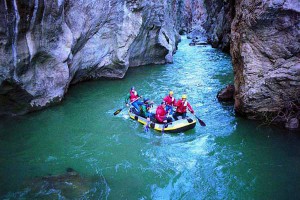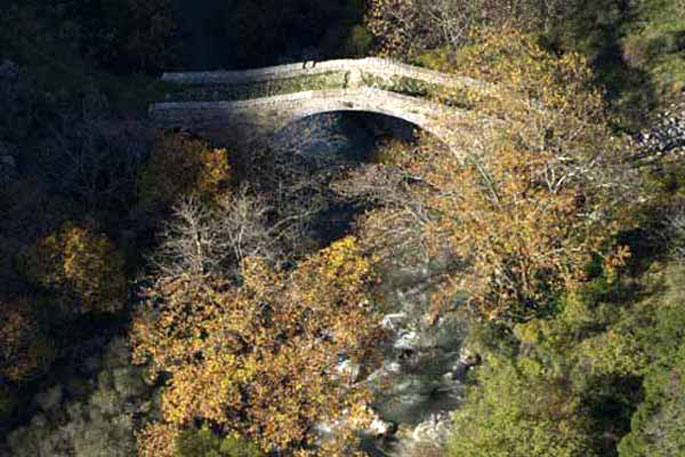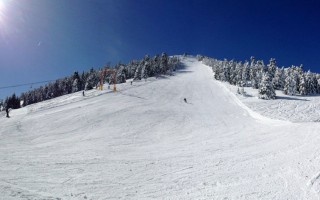Lousios is a Peloponnesian river and a tributary of Alfeios. It is a relatively small river, approximately 25 kilometres long. However the landscape that surrounds it on its both banks is magical. The name of the river has ancient origins. It is said that it was given this name because the newborn Zeus was bathed (Louzo=bathing) in its waters by the nymphs Theisoa, Neda and Agno.
 Near Karytaina, River Lousios crosses a gorge of substantial environmental importance, about 26 kilometres from its mouth. The natural beauty of this gorge fully justifies its characterization as a protected zone by the Ministry of Culture in 1997. Its flora is rich, and its fauna includes many species of reptiles, birds and even bats. There are numerous monasteries, churches and hermitages around the river, evidence of the religious life that developed there in the past.
Near Karytaina, River Lousios crosses a gorge of substantial environmental importance, about 26 kilometres from its mouth. The natural beauty of this gorge fully justifies its characterization as a protected zone by the Ministry of Culture in 1997. Its flora is rich, and its fauna includes many species of reptiles, birds and even bats. There are numerous monasteries, churches and hermitages around the river, evidence of the religious life that developed there in the past.
The gorge is ideal for a plethora of activities, like rafting and kayaking. It is a particularly impetuous river and is certainly not recommended for beginners. However, the crossing of the gorge is something suitable for everyone and a truly unique experience.
 Lousios originates in the location of the ancient town of Theisoa, near the village of Karkalou, as well as further to the north, near Kaloneri, in the location of the church of Agia Paraskevi. These two streams meet up in Karkalou, where Lousios continues its course, to end up after 25 kilometres in Alfeios and flow into somewhere near Karytaina. In its relatively short course, Lousios gives life to the entire surrounding area and dazzles with its natural beauty that includes flora, fauna, unique formations, waterfalls and an incredible gorge.
Lousios originates in the location of the ancient town of Theisoa, near the village of Karkalou, as well as further to the north, near Kaloneri, in the location of the church of Agia Paraskevi. These two streams meet up in Karkalou, where Lousios continues its course, to end up after 25 kilometres in Alfeios and flow into somewhere near Karytaina. In its relatively short course, Lousios gives life to the entire surrounding area and dazzles with its natural beauty that includes flora, fauna, unique formations, waterfalls and an incredible gorge.
 The gorge of River Lousios is one of the most impressive attractions in the prefecture of Arcadia. It is 15 kilometres long and around 2 kilometres wide. On its western side it goes through the National Trail 32, which is part of the European trail E4 GR that starts from Vytina, passing through the villages of Zygovisti, Dimitsana and Paliohori, the Monasteries of Philosophou and St. John the Baptist, then through Karytaina to end up in Gytheio. This entire area is truly amazing. The flora is rich and includes laurels, maples, willows, yews, myrtles, plane trees, elms, poplars, firs, olive trees and many more. The fauna is equally impressive, including various species of reptiles, birds, fish and mammals that live here throughout the year.
The gorge of River Lousios is one of the most impressive attractions in the prefecture of Arcadia. It is 15 kilometres long and around 2 kilometres wide. On its western side it goes through the National Trail 32, which is part of the European trail E4 GR that starts from Vytina, passing through the villages of Zygovisti, Dimitsana and Paliohori, the Monasteries of Philosophou and St. John the Baptist, then through Karytaina to end up in Gytheio. This entire area is truly amazing. The flora is rich and includes laurels, maples, willows, yews, myrtles, plane trees, elms, poplars, firs, olive trees and many more. The fauna is equally impressive, including various species of reptiles, birds, fish and mammals that live here throughout the year.
Religious and ascetic life developed on both sides of the gorge, especially during the Turkish occupation; something obvious from the existence of numerous monasteries, churches and hermitages, like the monasteries of Aimyaloi, Kalamiou, Philosophou, St. John the Baptist and the church of Agios Andreas of Gortyna. The wild beauty of the area combined with the serenity of nature were ideal for anyone who wanted to feel closer to God.
The gorge of River Lousios is perfect for many activities, like canyoning (crossing the river by various means), canoe-kayak, rafting, hiking and trekking. The hiking trails are numerous, each one with something different to offer. In 1997 the gorge was declared as an area of particular archaeological and environmental importance and was placed under the auspices of the Ministry of Culture.
Source: www.mythicalpeloponnese.gr













